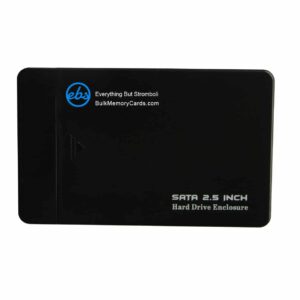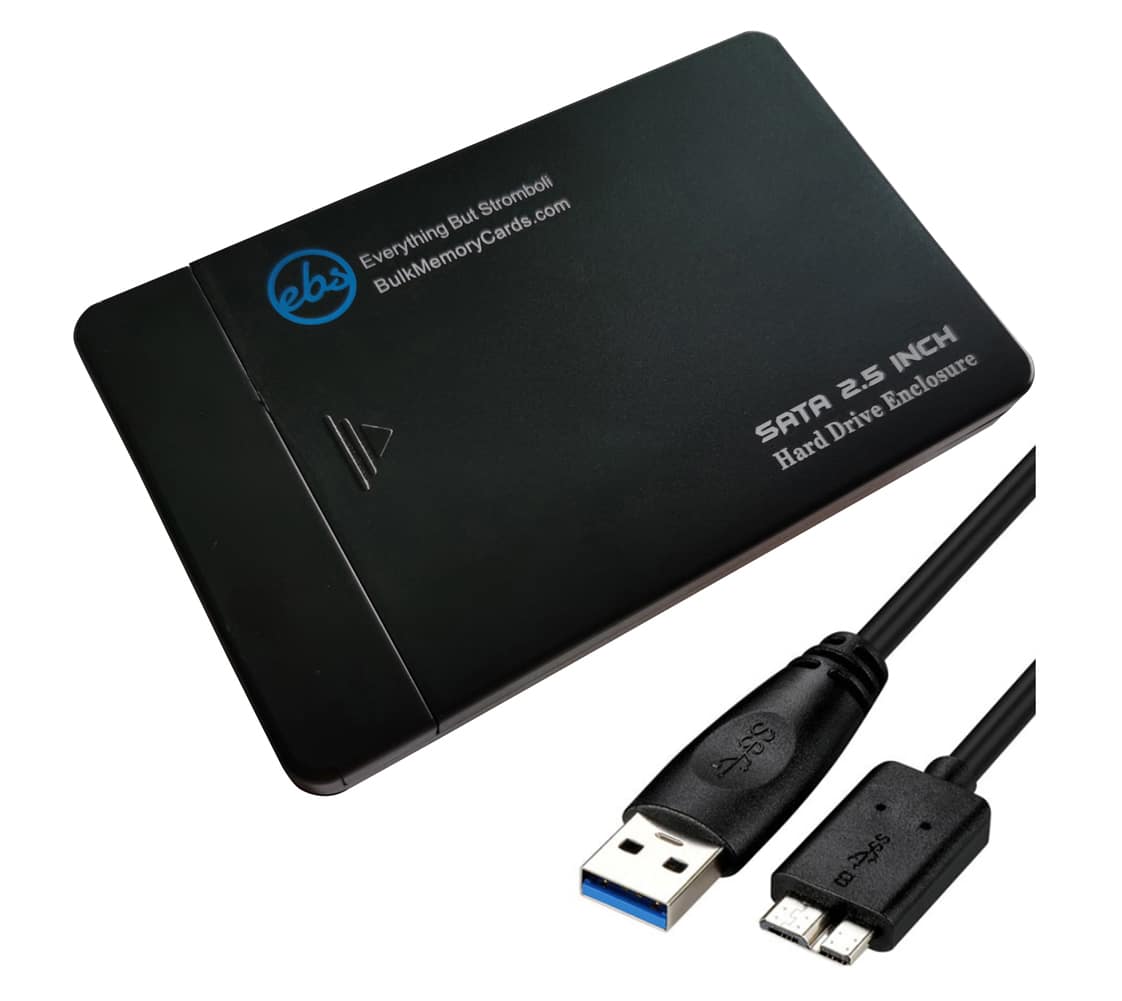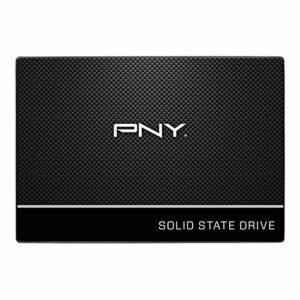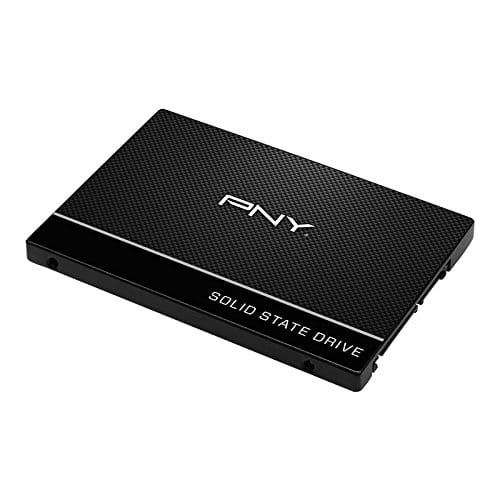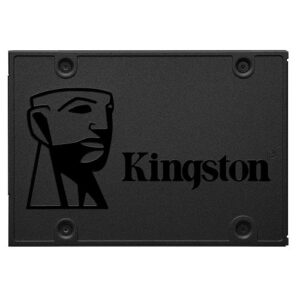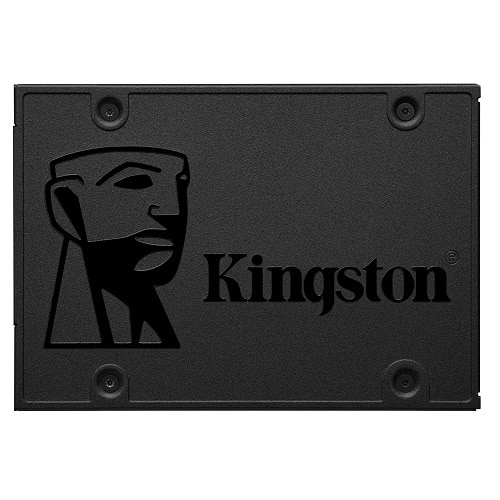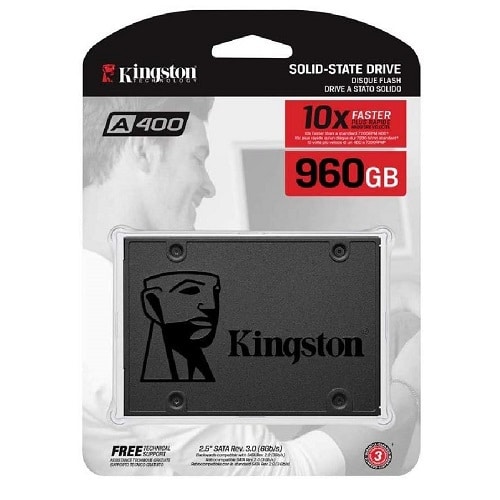SSDs | Solid-State Drives
Showing all 5 resultsSorted by price: low to high
-
Accessories
SSD Enclosure Everything But Stromboli Case for 2.5” Sata Hard Drive/ Solid State Drive
Simply open case and insert 2.5 Inch SATA HDD or SDD. Includes tool free Solid State Drive enclosure/2.5 HDD Enclosure case and (1) cable type A USB 3.0 to USB 3.0 micro B.
(1 review) -
SSDs | Solid-State Drives
250GB PNY SSD 2.5” Sata III Internal Solid State Drive (SSD7CS900-250-RB)
Get the PNY 250GB SSD CS900 and boost your computer’s performance! This solid state drive offers lightning-fast boot times and application launch speeds thanks to exceptional read and write speeds up to 535MB/s and 500MB/s respectively. Your programs, files, and media will load almost instantly compared to traditional hard disk drives.
With ultra-low power consumption, this SSD not only performs better but also saves on energy costs by using less electricity than typical HDDs. It consumes minimal battery too making it ideal for laptops. The 250GB capacity provides ample space to install your operating system, frequently used programs, games, and media files while maintaining speedy operation.
Backwards compatibility with SATA II 3GB/sec allows easy installation into most desktops and laptops. Simply, connect the SSD to an available SATA port and you can migrate your system and files to this faster drive in minutes. Thus, saving you time and performance. For a very affordable price, drastically boost productivity and enjoy snappier system performance with the easy upgrade to the PNY 250GB Internal SSD.
Specifications
- Model Number: SSD7CS900-250-RB
- Interface: SATA III
- Form Factor: 2.5″
- Read Speed: Max 535MB/s
- Write Speed: Max 500MB/s
- Operating Temperature: 0°C – 70° C
Shock and Vibration Resistant.
**This product comes in original retail packaging ready for resale. EBS return policy linked here.Model #: SSD7CS900-250-RB
(0 reviews) -
SSDs | Solid-State Drives
240GB Kingston SSD 2.5” Sata III Internal Solid State Drive (SA400S37/240G)
The Kingston 240GB SSD is a great option to replace your computer’s hard drive. With no moving parts, it has better longevity and speed.
Boosts the burst write performance, giving it great speed for PC workloads – Shock/vibration resistant for long lasting durability, so dropping your computer won’t ruin it all.
Specifications
- Model Number: SA400S37/240G
- Interface: SATA Rev 3.0
- Form Factor: 2.5″
- Read Speed: Max 500MB/s
- Write Speed: Max 350MB/s
- Total Bytes Written (TBW): 80TB
- Operating Temperature: 0°C – 70° C
- Vibration Operating: 2.17G peak
Shock and Vibration Resistant.
*Comes in retail packaging ready for resale. EBS return policy linked here.
Model #: SA400S37/240G
(0 reviews) -
SSDs | Solid-State Drives
480GB Kingston SSD 2.5” Sata III Internal Solid State Drive (SA400S37/480G)
The 480GB Kingston SSD is a great option to replace your computer’s hard drive. With no moving parts, it has better longevity and speed .
Boosts the burst write performance, giving it great speed for PC workloads – Shock/vibration resistant for long lasting durability, so dropping your computer won’t ruin it all.
Specifications
- Model Number: SA400S37/480G
- Interface: SATA Rev 3.0
- Form Factor: 2.5″
- Read Speed: Max 500MB/s
- Write Speed: Max 450MB/s
- Total Bytes Written (TBW): 160TB
- Operating Temperature: 0°C – 70° C
- Vibration Operating: 2.17G peak
Shock and Vibration Resistant.
*Comes in retail packaging ready for resale. EBS return policy linked here.
Model #: SA400S37/480G
(0 reviews) -
SSDs | Solid-State Drives
960GB Kingston SSD 2.5” Sata III Internal Solid State Drive (SA400S37/960G)
The Kingston 960GB SSD is a great option to replace your computer’s hard drive. With no moving parts, it has better longevity and speed.
Boosts the burst write performance, giving it great speed for PC workloads – Shock/vibration resistant for long lasting durability, so dropping your computer won’t ruin it all.
Specifications
- Model Number: SA400S37/960G
- Interface: SATA Rev 3.0
- Form Factor: 2.5″
- Read Speed: Max 500MB/s
- Write Speed: Max 450MB/s
- Total Bytes Written (TBW): 300TB
- Operating Temperature: 0°C – 70° C
- Vibration Operating: 2.17G peak
Shock and Vibration Resistant.
*Comes in retail packaging ready for resale. EBS return policy linked here.
Model #: SA400S37/960G
(0 reviews)
SSDs help speed up your computer by improving file access time. If you want to enjoy using a faster computer, consider investing in an SSD, also known as a solid-state drive. This next-level drive delivers an instant boost in system performance backed by durable and reliable advanced technology. SSD-powered computers boot faster, load software and files faster, and transfer files almost instantly.
In use since 1991, SSDs have soared in popularity in recent years as replacements to traditional hard drives. Solid-state drives are ideal solutions for gamers and anyone tackling multitasking operations in a desktop, laptop or notebook computer. If work is mobile, an SSD secures your data and gets you up and running quickly on the fly.
What Is SSD?
SSD, short for solid-state drive, is a flash-based mass-storage device. SSDs are manufactured in traditional hard disk drive form factors such as 5.25 inches, 3.5 inches, 2.5 inches and 1.8 inches.
Most desktop computers use 3.5-inch SSDs, with laptops home to 2.5-inch drives. SSDs in the 5.25-inch size are less common and typically used in backup devices. The smallest solid-state drives, 1.8-inch drives, are generally used as removable drives in ultramobile applications.
How Does SSD Work?
An SSD does not use electricity or moving parts like a traditional hard drive with spinning plates inside. SSD technology operates more like a USB flash drive, with both using nonvolatile memory that doesn’t need electricity for digital storage capacity. A solid-state drive can store and retrieve data much faster than any hard drive. Without moving parts in an SSD-powered laptop, you can toss it in a computer bag, jostle it about on your way to a meeting and pop it open to an almost instant display for a presentation.
An average SSD drive operates at 500 MB per second read speed and an estimated 400 MB per second for write speed. SSD systems are 10 times faster at everything compared with traditional hard drives. Because SSD drives contain no moving parts, there is no electric-powered “boot” cycle, and your SSD is quieter and cooler while you work.
What Size SSD Do I Need?
Storage capacity in SSDs has increased rapidly in recent years. Most work or personal use can be performed using solid-state drives in the 120 GB to 480 GB storage range. This may seem limited compared with large terabyte hard drives on the market, but SSD systems are designed for durability, performance and efficiency.
SSD systems operate at peak capabilities when needed, and excess storage needs can be accomplished via external storage options such as external hard drives and cloud-based drives such as Google Drive, Dropbox and Box.
For most computer users, SSDs in the 120 GB to 480 GB range offers plenty of space for a computer operating system along with programs. Many computer users store files such as documents, images, audio and video files using external drives and/or cloud-based solutions. Some others rely on companies such as Google or Microsoft for document storage, Amazon for book storage, Spotify for music and Google Play for purchased movies and television shows. Today’s web-based, cloud-oriented computer world has helped pave the way for SSDs, although with smaller capacities compared with spinning-disk hard drives, to soar in usage and popularity.
Bulk SSDs
SSDs’ extraordinary read and write speeds and reliability these high-tech drives an attractive option for any new system. Many are even choosing to revive their older systems with the addition of SSDs.
Recent SSD price drops have only further fueled many computer users’ desire to upgrade their systems to the performance level only an SSD can deliver. You’ll enjoy the value of your investment every time you turn on your device for work or pleasure.
Modern computer users have a never-ending craving for dependability, speed, and performance in their devices. An SSD delivers on all counts, and we can deliver with offers on your SSD purchase.
Everything But Stromboli has made easy the process of buying bulk SSDs. Save with wholesale discounts on SSDs when you purchase in quantities of 10, 50, 100, 500 or 1,000 drives.
How to Format SSD
SSDs may be formatted quickly and easily using Windows and Macintosh computers to erase all stored data.
How to Format SSD Windows 10
To format SSD on Windows 10, connect the drive to your computer and open Disk Management by pressing the Windows key and “R” to open the “run” dialog box. Key in “diskmgmt.msc.” Now right-click the solid-state drive partition and select “Format.”
In the pop-up window, you can label the volume, change the file system and perform a quick format. Only SSD partitions whose sizes are smaller than or equal to 32 GB can be formatted from NTFS to FAT32 through the Disk Management app.
Some advise to check the “Quick Format” box, saying that, otherwise, your computer will go through a full format, possibly shortening the life of your SSD. With traditional hard drives, fully formatting a drive is acceptable.
How to Format SSD on Mac
To format SSD on a Mac, connect the drive to your computer. External solid-state drives can be connected using USB or Thunderbolt cables, and internal SSDs can be linked up using external enclosures.
Launch the Utilities option via the “Go” menu in the Finder. Launch the Disk Utility app and click on the icon for the drive you’d like to format.
Next, open the “Erase” tab, located at the top of the Disk Utility window. Change the volume format menu to “Mac OS Extended (Journaled).” You can then edit the name of the solid-state drive in the “Name” field. Finally, click on “Erase.”

